Hopefully this will help some of you with your chuck issues.
Over the years I have owned several used metal lathes. They all came with 3-Jaw chucks that were well used and not accurate enough to suite me. I used this step by step process to improve them. How much improvement depends on how worn and abused each chuck was.
I recently got a 1947 "Monkey Wards" 10" x 24" Logan lathe. The chuck was pretty beat. This is what I did to it.
The chuck pictured is the original "Logan" chuck that came with the lathe. Notice the grip face of the jaws. They are mutilated beyond usefulness. No chuck should be treated like that.
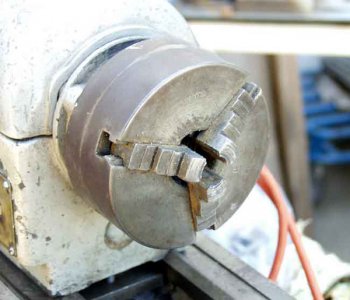
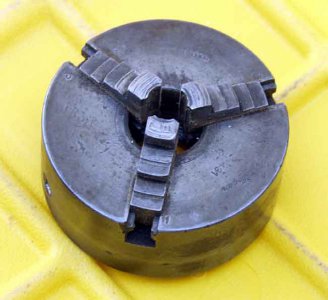
The first thing is to remove the jaws and degrease all the parts.
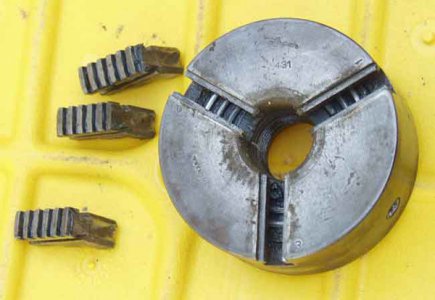
The grip face of each jaw, needs to be narrowed to bring it back close to the original width, in order to hold small stock. Excess material is removed from each jaw on the belt sander.
The first thing is to prepare the sander table by setting it perpendicular to the belt.
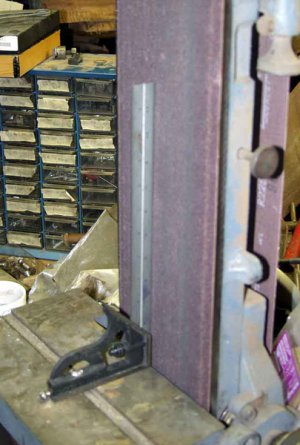
A guide is clamped to the table to in order to grind the proper angle to each side of each jaw. The guide will need to be reversed in order to grind the other side of each jaw.
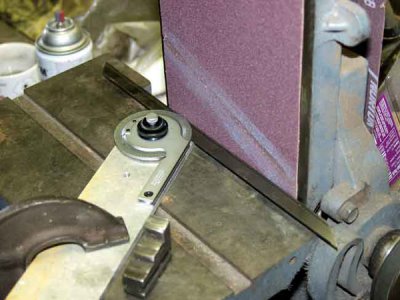
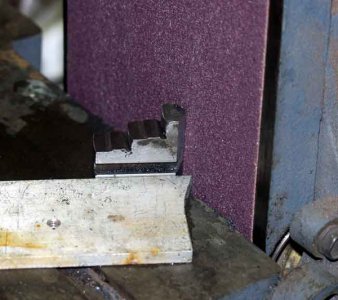
Sand/grind the surfaces trying to remove stock equally off each jaw surface.
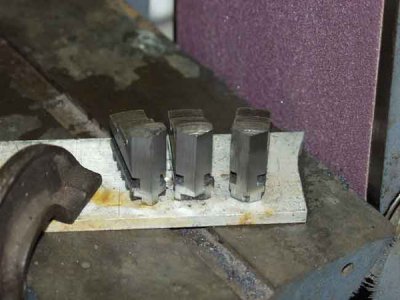
With care the jaws can be ground fairly accurately on the sander. I only rough them on the sander and finish them on a surface grinder.
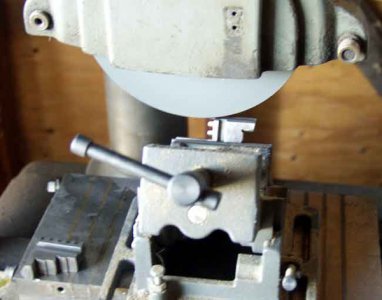
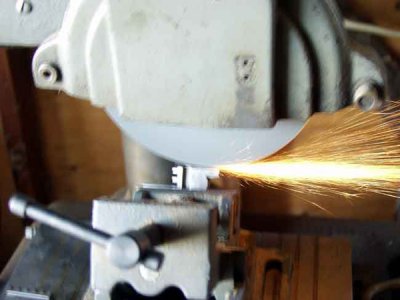
The jaws after surface grinding.
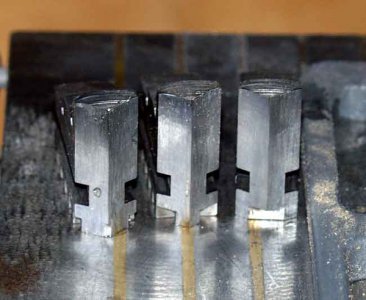
The lathe the chuck went on was not operational at the time I did this. Normally, I would perform the next steps on the lathe that uses the chuck. To work around this issue, I mounted a piece of stock in my operational lathe and threaded it to fit the chuck thread.
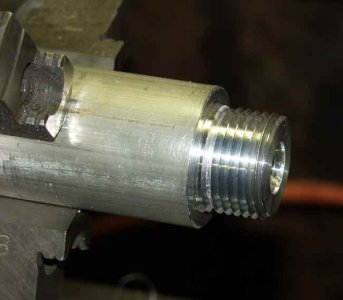
The chuck has been taken apart. The internal parts, scroll & pinion gear were removed and the chuck halves reassembled. The chuck was them mounted on the threaded arbor.
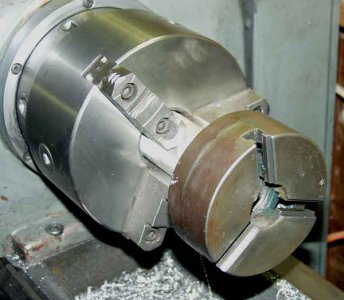
A tool-post grinder was used to grind the various faces. Grinding the faces is not required in order to refurb the jaws but it squares up the chuck faces and gives it a fresh appearance. I run the lathe in the opposite direction of rotation to that of the grinding wheel though it isn't critical. A slow lathe RPM is used and a very slow feed rate. The grinding takes a long time since only small amounts of stock can be removed on each pass.
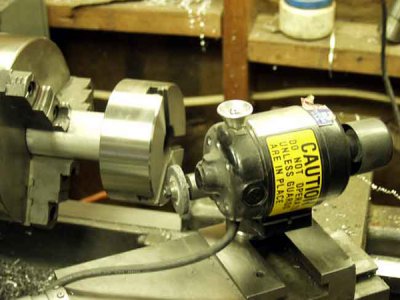
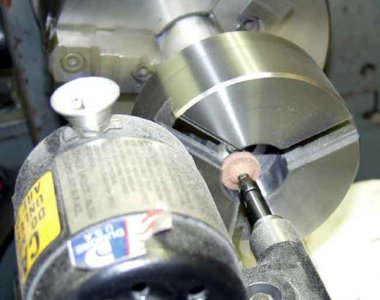
Once all the grinding is completed, the chuck is removed from the threaded arbor. It is taken apart and all the parts are cleaned, oiled, reassembled and placed back on the threaded arbor.
A ring is placed around the jaws and tightened holding the ring firmly in place. This takes the back-lash out of the jaws in preparation for grinding the grip face of the jaws. Again a slow RPM and feed is used and several LIGHT passes are made. This trues up the jaw faces, making them concentric to the spindle axis.
The larger 8" chuck holding the threaded arbor went through this process a few years ago when I got the lathe as it was pretty rough and not accurate when I got it.
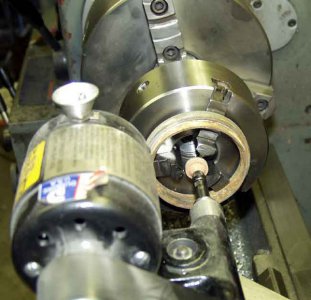
Remove the finished chuck from the arbor. It is a good idea to take the chuck apart and clean grinding waste off of the parts, relubricate each part and reassemble them. I prefer using oil over grease to lubricate the chuck parts. With use, chips manage to get into the chuck. I find it easier to occasionall remove the jaws and blow the chips out of the chuck. Eventually I find it necessary to disassemble the chuck and clean all the parts with mineral spirits, oil and reassemble the chuck.
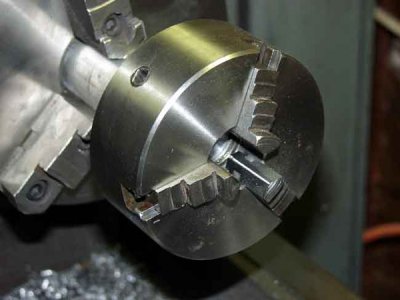
Mount the chuck back on your lathe and enjoy a chuck that is as true as it can be made. Notice the narrow grip face on the refurbbed jaws.
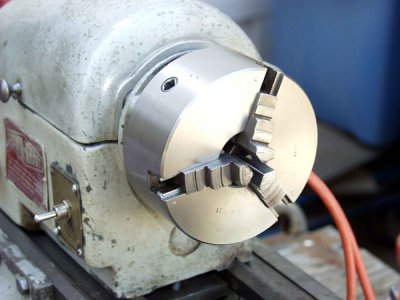
Not all chucks will yield great results but this has worked for me quite well on all the used chucks I have had. I have only owned 2 new chucks but I grind the jaws on new chucks to make them as accurate as I can.
I didn't always have a tool post grinder. I have rigged up a Dremel, hand grinder and a home made tool post grinder for doing the grinding. One of the most important things is to dress the grinding stone before using it.
I had a 6" chuck on my last lathe which was 25 years old. It never saw any crashes or embarrassing event that could have damaged it. I kept it clean and oiled and it stayed accurate to 2 thousandths or less runout.
Hope this helps you do yours.
Charlie W.
Over the years I have owned several used metal lathes. They all came with 3-Jaw chucks that were well used and not accurate enough to suite me. I used this step by step process to improve them. How much improvement depends on how worn and abused each chuck was.
I recently got a 1947 "Monkey Wards" 10" x 24" Logan lathe. The chuck was pretty beat. This is what I did to it.
The chuck pictured is the original "Logan" chuck that came with the lathe. Notice the grip face of the jaws. They are mutilated beyond usefulness. No chuck should be treated like that.


The first thing is to remove the jaws and degrease all the parts.

The grip face of each jaw, needs to be narrowed to bring it back close to the original width, in order to hold small stock. Excess material is removed from each jaw on the belt sander.
The first thing is to prepare the sander table by setting it perpendicular to the belt.

A guide is clamped to the table to in order to grind the proper angle to each side of each jaw. The guide will need to be reversed in order to grind the other side of each jaw.


Sand/grind the surfaces trying to remove stock equally off each jaw surface.

With care the jaws can be ground fairly accurately on the sander. I only rough them on the sander and finish them on a surface grinder.


The jaws after surface grinding.

The lathe the chuck went on was not operational at the time I did this. Normally, I would perform the next steps on the lathe that uses the chuck. To work around this issue, I mounted a piece of stock in my operational lathe and threaded it to fit the chuck thread.

The chuck has been taken apart. The internal parts, scroll & pinion gear were removed and the chuck halves reassembled. The chuck was them mounted on the threaded arbor.

A tool-post grinder was used to grind the various faces. Grinding the faces is not required in order to refurb the jaws but it squares up the chuck faces and gives it a fresh appearance. I run the lathe in the opposite direction of rotation to that of the grinding wheel though it isn't critical. A slow lathe RPM is used and a very slow feed rate. The grinding takes a long time since only small amounts of stock can be removed on each pass.


Once all the grinding is completed, the chuck is removed from the threaded arbor. It is taken apart and all the parts are cleaned, oiled, reassembled and placed back on the threaded arbor.
A ring is placed around the jaws and tightened holding the ring firmly in place. This takes the back-lash out of the jaws in preparation for grinding the grip face of the jaws. Again a slow RPM and feed is used and several LIGHT passes are made. This trues up the jaw faces, making them concentric to the spindle axis.
The larger 8" chuck holding the threaded arbor went through this process a few years ago when I got the lathe as it was pretty rough and not accurate when I got it.

Remove the finished chuck from the arbor. It is a good idea to take the chuck apart and clean grinding waste off of the parts, relubricate each part and reassemble them. I prefer using oil over grease to lubricate the chuck parts. With use, chips manage to get into the chuck. I find it easier to occasionall remove the jaws and blow the chips out of the chuck. Eventually I find it necessary to disassemble the chuck and clean all the parts with mineral spirits, oil and reassemble the chuck.

Mount the chuck back on your lathe and enjoy a chuck that is as true as it can be made. Notice the narrow grip face on the refurbbed jaws.

Not all chucks will yield great results but this has worked for me quite well on all the used chucks I have had. I have only owned 2 new chucks but I grind the jaws on new chucks to make them as accurate as I can.
I didn't always have a tool post grinder. I have rigged up a Dremel, hand grinder and a home made tool post grinder for doing the grinding. One of the most important things is to dress the grinding stone before using it.
I had a 6" chuck on my last lathe which was 25 years old. It never saw any crashes or embarrassing event that could have damaged it. I kept it clean and oiled and it stayed accurate to 2 thousandths or less runout.
Hope this helps you do yours.
Charlie W.





